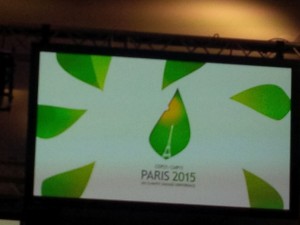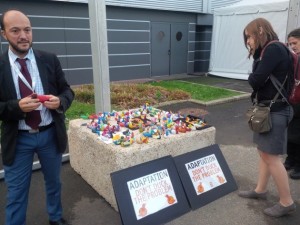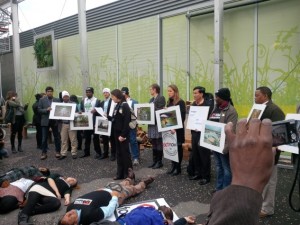-
End of week 1 Blog
Posted on December 6, 2015Life has become, for a short period, a fixed routine. I leave my studio flat in Montmartre at 7 30 and walk for 15 minutes to the Gare du Nord. Free transport is provided for COP 21 participants so Metro to Le Bourget and shuttle bus to the Parc des Expositions where COP 21 is being held.
I pick up my free apple (20, 000 given away daily !), go through security, sound the alarm each time as I have metal hips so am thoroughly searched, and arrive at the stand around 8 30.
All is relatively peaceful at this time but by 11 am it is almost impossible to get on to the internet as there is insufficient bandwidth (so I am told !) and the world has arrived by then – all 30,000 of them.
Invariably there is a small demonstration of some sort as the multitudes arrive, in the main street separating the Exhibition Hall, where our stand is located, and many of the country pavilions.
I learnt on Friday at a briefing by Christiana Figueres, the Executive Secretary of the UNFCCC, to 500 representatives of Observer Organisations that the ratio of government delegates to observers was 2 : 1.
The session, which began late and ended early (pressure on her time), was a Q&A from which we learnt that the Paris Agreement will be adopted here in Paris at the end of the COP and then signed in the US probably on 22 April next year.
As to the talks themselves she said it was premature to know where they would end – « it is difficult to get 195 parties to agree » – which was a little discouraging if not familiar! They have a week to come up with the agreement
She re-stated that the single greatest impact to solving the crisis would be the transformation of coal and gas and went on to say « We the people are the ones who have caused the problem therefore we must take responsibility for solving it »
I was extremely sorry to see Keith depart on Friday – he managed to keep me sane during the week, was a great asset to the delegation and a lot of fun to boot ! I did not envy his return to his homeland which was due to coincide with that of Storm Desmond.
His place will be taken next week by Josh Gilbert, a young Australian (referred to in an earlier blog) who is here with Anika. Andrew Potts is also leaving (on Sunday) and we will be joined by Cristina Banahan, one of his team at US ICOMOS.On Saturday I attended a very interesting side event entitled ‘Loss and Damage – Who should pay?’ I particularly wanted to go to this since we had been involved in this topic at COP 18 in Doha when we changed the draft text to include the word ‘culture’ before signing an open letter to Ministers on Loss and Damage.
Loss and Damage are the costs and impacts of climate change once mitigation and adaptation has failed. Extreme events would be such an example where Loss and Damage might come into play.
One of the speakers, Maina Talia from Tuvalu, who I remembered meeting in Doha, gave an impassioned presentation about the effects of climate change on his small Pacific island – 8 islands in fact, covering 27 sq km and a total population of 10,000.
He told us there was no room for individualism – their culture was all about the community and communal living ; some had migrated to Australia and New Zealand but they were the « bad ones »
He explained that migration was not the answer and gave a very compelling reason why not. Their land is hugely important. It is part of their custom that when a baby is born, the mother buries the placenta and a coconut tree is planted on top. So each individual is ‘rooted’ and connected to the land – they can’t leave and are not advocating to leave. I thought this was another splendid example of intangible cultural heritage.
I was prompted to ask a question at the end as to how they would value the loss of culture in arriving at a figure for loss and damage. Somewhat disconcertingly Maina replied : « Loss of culture equals death » !
The two other speakers were from the Heinrich Boell Foundation and the Climate Justice Programme. The latter outlined the cost of three extreme events and compared those to the profits of a different major fossil fuel company in one year.
One example was the drought in Kenya, Uganda and Ethiopia between 2008-2011 when 13.3 million in Kenya alone suffered food shortages and many died. The losses were $12.1 bn whereas Shell’s profits in 2013 were $90.2 bn. There is surely a message there in terms of who pays.
I will report the outcome of our discussions at the UNESCO Pavilion in the next BlogOliver Maurice 5/12/2015

 44 (0)20 7824 7157
44 (0)20 7824 7157


